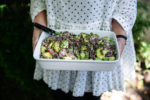How Many Of These Questions On Climate Change Solutions Can You Get Correct?
Eco-consciousness is no longer a polite suggestion; it’s a necessity. Ocean temperatures are rising, forests are burning, species are disappearing and children are worried for their futures – climate change is very real. Our daily luxuries and comforts come at the expense of the planet we share with millions of other species. Fortunately, people are listening! The first step of eco-consciousness is understanding the consequences of inaction and moving toward positive change. Do you drink from a reusable water bottle? Do you bike to work? Do you recycle your jam jars? Many of us are already doing things every day to reduce our carbon footprint, but it may surprise you which choices have a greater impact than others!
How much do you really know about climate change solutions? BWB has a little quiz for you: Rank the solutions of each category from most to least beneficial. The answers are written out below each card. Good luck!

A third of produced or farmed food doesn’t make it onto our plates. When it does make it to our plates, we don’t always finish it. This wasted food accounts for about 8 percent of global emissions. Exhaustive amounts of greenhouse gases are emitted at every stage of the food production process, which means reducing food waste would have the greatest positive impact.
Order: A, C, B

You might not realize it, but our refrigerators and air conditioners work with chemicals that have a thousand times greater capability of heating the atmosphere than that of CO2. We need to switch to cleaner chemicals and prevent leakage.
Order: B, C, A

Compared to other renewable energy sources, onshore wind farms are the ideal alternative. They’re quick to build and land-efficient, meaning they can operate simultaneously alonside grazing, farming and recreation.
Order: C, A, B

We’ve lost 7 percent of our tropical forests. These ecosystems are essential to the well-being of our planet, as they support the water cycle, conserve soil, supply food and medicine, and provide a home for people and wildlife alike. Flora and fauna are able to absorb and hold carbon; bamboo is one of them!
Order: C, B, A

Saving the planet can be as simple as a switch of a light. Compared to incandescents or fluorescents, LED bulbs use less energy, last longer, and offer you the same amount of light without the toxic mercury.
Order: C, A, B

Action starts with knowledge, but more importantly, equal opportunity. When it comes to cutting down on carbon emissions, educating women is key in slowing down population growth. Women who have more years of education under their belt have fewer and healthier children, all while making greater contributions to their communities and the economy.
Order: B, A, C
Inspired by CNN & Project Drawdown.

Originally from Los Angeles, Alicia lived in Shanghai for 11 years before moving back to the states to attend the University of Miami, where she graduated with a bachelor’s degree in public relations and minors in art and philosophy. Currently residing in New York City, Alicia applies her knowledge of strategic communication and design in her career. She enjoys painting, rugby, exploring, and more often than not, you’ll find her petting someone’s dog.







